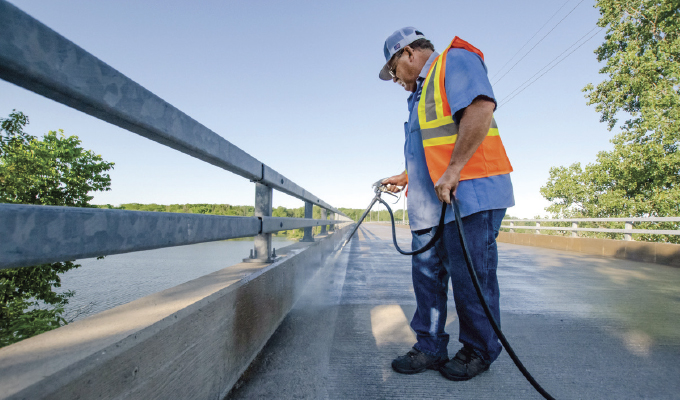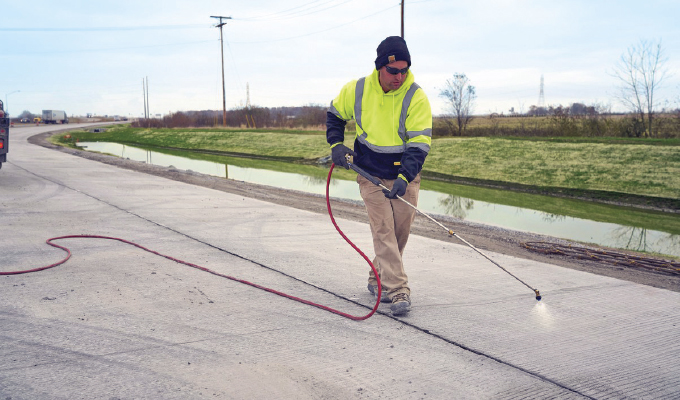In 2011, the Indiana Department of Transportation and Purdue University launched a study to evaluate the effectiveness of a new soy-based concrete protection product developed by the university. INDOT had approached Purdue a few years earlier, seeking a way to prevent concrete joint deterioration on state highways—a costly problem that has long plagued transportation networks. In response, researchers at Purdue created an innovative mixture of soy methyl esters (SME) and polystyrene—a new approach to concrete preservation called PoreShield™.
The test location in that study was a busy stretch of 13-year-old concrete roadway on U.S. Highway 231 in Lafayette, Indiana. Six slabs were treated with PoreShield, while six more slabs were left with no protection and the remaining sections kept their existing silicone sealant as a control group. When the test area was evaluated 10 years later, the treated sections looked the same as the day PoreShield was applied, while the untreated sections and control sections showed heavy deterioration.
Since that first test began more than a decade ago, PoreShield has proven itself repeatedly in the real world and in the lab—not just for its protective capabilities, but also for its safety, sustainability, and cost-effectiveness. Read on to see how PoreShield works and how it has protected a variety of infrastructure.

A HOMEGROWN SOLUTION
Paul Imbrock helped develop PoreShield as an undergraduate research assistant at Purdue and has worked to refine and promote PoreShield ever since. Imbrock joined Crafco, Inc. when the company acquired PoreShield earlier this year. He says PoreShield is fundamentally different than conventional silane-based sealers because it soaks into the concrete instead of merely sitting on top.
“We were interested in SME from the start because of its ability to spread thinner than water,” Imbrock says. “Where other solutions work as a film cover, PoreShield protects from within the pores, preventing outside elements from entering the pores.”
Those outside elements include salt ions that can interact with concrete and cause serious cumulative damage. Moisture can also damage concrete when it expands at freezing temperatures, breaking the concrete structure. While conventional sealers tend to wear away or crack within a few years, PoreShield works inside the concrete, staying effective for 10+ years. Concrete protected by PoreShield has no place for ions and moisture to penetrate and do their damage.
In addition to working differently and lasting longer, PoreShield offers a safer alternative to toxic silane sealers. Made from American-grown soybeans, PoreShield is low-VOC, nonhazardous to humans and the environment, and doesn’t require PPE for application. PoreShield also satisfies the increasing focus on sustainability. Because soybeans are already commonly grown for a variety of other purposes, PoreShield benefits from a reliable, renewable crop supply and existing economies of scale. It has earned the USDA BioPreferred seal due to its renewable soy-derived technology and meets the requirements of the 2021 Build America, Buy America Act, which requires all federally funded infrastructure projects to use products sourced and made in the United States.
Contractors and public agencies love PoreShield’s ease of application. With just a simple sprayer, minimal surface preparation and no special training, PoreShield can be sprayed quickly on long stretches of highway joints, bridge decks, and other concrete applications.
In 2020, Tony Korba, concrete operations manager at E&B Paving, applied PoreShield to 14 miles of PCCP joints on I-65 near Seymour, Indiana. He used a recreational vehicle retrofitted with a sprayer and two hoses to allow two workers to apply PoreShield at the same time.
“It was basically as fast as you could walk,” Korba says. “The speed of the application was just unbelievable compared to a sealant.”

GROWING ACCEPTANCE
Following the application to I-65, the Indiana Department of Transportation published a unique special provision specifying “soy-based penetrating sealers for PPC joints.” INDOT wrote PoreShield into its design manual specification, allowing it for use as a general part of PCCP design. Several other state DOTs have used PoreShield on their projects, including Arkansas, Iowa, South Dakota, Wisconsin, Texas, Oregon, Washington, and Nebraska—not to mention numerous city and county public works departments.
PoreShield isn’t limited to just transportation projects. It has been applied to a wide variety of concrete surfaces, including hog barns, building foundations, loading docks, sidewalks, parking garages, road salt storage buildings, the Indiana State Fairgrounds and even a water park. Whether sprayed on cured concrete or used as an admixture, PoreShield provides the same simple application and long-lasting protection.
CLOSING THOUGHT
Rigorous tests by independent laboratories and state agencies have proven PoreShield’s potential as the future of concrete preservation. One test involved freezing and thawing samples of concrete 300 times in a salt solution to simulate long-term weathering and exposure to deicing salt. At the end of the test, the samples treated with PoreShield looked almost new and showed no damage, while the silane-treated samples and the untreated control group both showed significant scaling and loss of mass. Other third-party tests have borne out PoreShield’s ability to inhibit water absorption, chloride ion diffusion, stain absorption, calcium oxychloride formation and more.
“We subjected PoreShield to these tests because we truly believe in it,” Imbrock says. “A solution is only valuable if it actually works, and we want PoreShield to earn the trust that concrete professionals have put in it.”
For More Information:
For more about Crafco’s PoreShield™, visit www.poreshield.com.
Modern Contractor Solutions, September 2023
Did you enjoy this article?
Subscribe to the FREE Digital Edition of Modern Contractor Solutions magazine.



